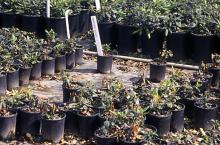See:
Rhododendron - Phytophthora Root Rot
Rhododendron - Ramorum Leaf Blight and Shoot Dieback
Cause Many different Phytophthora species, fungal-like microorganisms, can cause blights and dieback of Rhododendron alone without necessarily producing a root rot phase. Phytophthora syringae, is common during the cool winter months. P. plurivora is common during warmer months and is most active in summer. Phytophthora cactorum, P. citricola, P. parasitica, and P. heveae also can produce leaf spots and dieback and are also active in warm summer weather. Other species active in the PNW include P. gonapodyides and P. hibernalis. Also, P. ramorum is yet another species that can cause similar symptoms but is a quarantined pest. Not only can one find a different set of species at different times of the year, but different sets of species can also be found from nursery-to-nursery.
Rain-splashed or wind-blown inoculum begins the infection. A film of water is necessary for germination and infection. Container plants falling over into contaminated puddles can also start the process. Lower leaves seem to be more typically infected, as they are closer to inoculum sources. Leaf-to-leaf contact can also spread the disease. Young leaves are more susceptible than older leaves. Depending on the species involved, low temperatures and wounds can also favor disease development. Periods of leaf wetness and favorable temperatures encourage the production of sporangia in lesions, continuing the disease cycle. Healthy plants spaced close to infected plants can become infected by inoculum spread by rain or irrigation. Lower leaf surfaces are more susceptible to infection than upper surfaces, most likely due to stomata as infection courts. Oospores form in infected leaves and survive until the next rainy season. Survival is best when host tissue is kept moist and intact. Low-leaf nitrogen levels result in smaller leaf spots and less symptom development for several species.
Symptoms Leaf spots produced by P. syringae are irregular and necrotic and usually start on leaf edges or tips. Infected leaves usually fall off. Leaf spots by other species start out generally circular on young leaves as water-soaked lesions that then turn chocolate brown. Lesions expand leaving the central area dried out and brittle. Lesions may expand into and down the midrib and into the petiole. Lesions may appear wedge-shaped as they progress along the leaf. Necrosis may continue from the petiole into the stem resulting in a diamonded-shaped canker. Entire shoot tips may wilt and dieback. Young plants may die completely while older plants may survive for a few years. Branch cankers produced by P. syringae are shiny black but not sunken. Usually the tip dies back, and the branch defoliates.
Spots are easily confused with leaf scorch, chemical damage, or various mechanical injuries. Spotting symptoms due to various Phytophthora species are difficult to distinguish and are dependent on cultivar and temperature. Contact your Department of Agriculture for an accurate diagnosis if you see or suspect plants with symptoms caused by P. ramorum.
Cultural control Use many different tactics to manage these diseases but development of an appropriate water management plan is the best cultural practice.
- Propagate cuttings only from plants known to be free of disease for several months. Use clean, pathogen-free potting media and clean, new pots.
- Manage the application of irrigation water to reduce the length of time that foliage is wet. If possible, increase the interval between waterings. Use drip irrigation when practical.
- Use only clean water for irrigation. Treat surface irrigation water to kill spores.
- Provide good drainage for plants in beds, fields, or containers. Place containers on gravel beds (4 inches or more deep) or raised benches to allow drainage. Do not place containers on poly sheets; they can prevent containers from draining into soil and allow contaminated drainage water to spread from the base of one container to another. Improve drainage to avoid puddling and splashing in established areas.
- Space plants out for good air circulation that promotes drying.
- Prune off infected leaves and branches.
- Rake up and destroy dead leaves around the base of plants.
- Avoid reusing pots from a previous crop for propagation. If pots must be reused then wash off all debris and soak in a sanitizing solution or treat with aerated steam for 30 min.
- Prevent potted plants in nurseries from falling over allowing foliage to touch the ground.
- In the landscape, use a mulch layer of composted bark to help prevent rain or irrigation splash.
- Use an appropriate amount of ammonium nitrogen fertility avoiding excess levels.
Chemical control Use before symptoms are expected to show. The Group 4 and Group P7 fungicides used to manage Phytophthora do not kill this organism. They can only prevent establishment of the organism before it gets into the plant. They can also prevent continued growth if the organism is already inside the plant thereby delaying symptoms that might have developed. Once chemical activity has subsided with time, the organism can resume growth within infected plants. Alternate or tank-mix products from different groups that have different modes of action. Limit the use of any one group during crop production.
- Adorn at 2 to 4 fl oz/100 gal water plus another fungicide. Group 43 fungicide. 12-hr reentry.
- Aliette at 2.5 to 5 lb/100 gal water. Do not use with adjuvants. Group P7 fungicide. 24-hr reentry.
- Areca at 2.5 to 5 lb/100 gal water as a foliar application. Group P7 fungicide. 12-hr reentry.
- Broadform at 2 to 4 fl oz/100 gal water. Group 7 + 11 fungicide. 12-hr reentry.
- Daconil Weather Stik at 1.38 pints/100 gal water. Group M5 fungicide. 12-hr reentry.
- Fenstop at 7 to 14 fl oz/100 gal water. For greenhouse use only. Group 11 fungicide. 12-hr reentry.
- Fosphite at 1 to 2 quarts/100 gal water. Do not use copper products within 20 days of treatment and do not use spray adjuvants. Group P7 fungicide. 4-hr reentry.
- Heritage at 1 to 4 oz/100 gal water plus a non-silicone-based wetter sticker. Group 11 fungicide. 4-hr reentry.
- Insignia SC at 6 to 12 fl oz/100 gal water. Do not use with organosilicate-based adjuvants. Use preventively only. Group 11 fungicide. 12-hr reentry.
- Mancozeb-based products can be used as mixing partners and provide some protection. Group M3 fungicides. 24-hr reentry.
- Fore 80 WP at 1.5 lb/100 gal water plus a spreader-sticker.
- Protect DF at 1 to 2 lb/100 gal water plus 2 to 4 oz spreader-sticker.
- Mefenoxam 2 AQ at 0.49 to 1.96 fl oz/100 gal water plus another fungicide with a different mode of action. Can be used as a soil drench for Rhododendron but would be ineffective. Group 4 fungicide. 48-hr reentry.
- MetaStar 2E at 1.25 to 2.5 fl oz/100 gal water as a foliar spray. Group 4 fungicide. 48-hr reentry.
- Micora at 4 to 8 fl oz/100 gal water. Group 40 fungicide. 4-hr reentry.
- Monterey Garden Phos at 2 to 4 teaspoons/gal water as a foliar spray. Also labeled for soil drench, see label for details. Can be used in landscape sites. Group P7 fungicide. H
- Orvego at 14 fl oz/100 gal water. Group 40 and 45 fungicide. 12-hr reentry.
- OxiPhos at 1.3 to 4 quarts/100 gal water as a foliar spray. Group P7 fungicide. 4-hr reentry.
- Phospho-Jet is registered at 1 to 2 quarts/100 gal water as a foliar spray. Group P7 fungicide. 4-hr reentry.
- Segovis at 0.6 to 3.2 fl oz/100 gal water plus another fungicide. Maximum of 2.4 fl oz/A. Group 49 fungicide. 4-hr reentry.
- Sparra at 12 to 24 fl oz/100 gal water as a soil drench or 1 to 2 quarts/100 gal water as a foliar spray. Group P7 fungicide. 4-hr reentry.
- Stature SC at 12.25 fl oz/100 gal water. Group 40 fungicide. 12-hr reentry.
- Subdue MAXX at 0.5 to 1 fl oz/100 gal water plus another fungicide with a different mode of action. Group 4 fungicide. 48-hr reentry.
- Zonix at 45 to 76 fl oz/100 gal water. Can be sprayed on crop or injected into irrigation system. Short residual so may have to be used frequently for adequate results. 4-hr reentry.
References Knaus, B.J., Fieland, V.J., Graham, K.A., and Grünwald, N. J. 2015. Diversity of foliar Phytophthora species on Rhododendron in Oregon nurseries. Plant Disease 99:1326-1332.
Linderman, R.G., and Davis, E.A. 2008. Evaluation of chemical agents for the control of Phytophthora ramorum and other species of Phytophthora on nursery crops. Online. Plant Health Progress doi:10.1094/PHP-2008-0211-01-RS.



